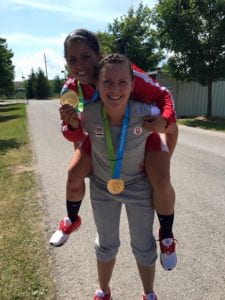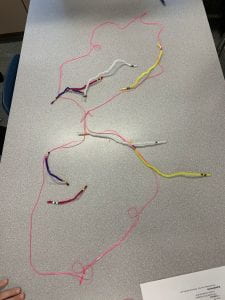This graphic novel was made using pixton.com that shows what I learnt about A midnight summers dream. I showed the parts of the play that I felt were the most important and I tried to show it my best!
What I learned about linear relations
What is a linear relation?
A linear relation is when you have variables that are going up and changing by the same number, that ends up making a straight line on the graph. For example: 2, 4,6,8… So you can see they all go up by the same amount each time.
How to find the rule for a pattern
To find the rule, firstly you have to make a T chart. One side is X and one side is Y. You can write any numbers in the X collum but normally just like 1-3. Once you finish filling out the chart you look at the Y collum to see what the numbers are decreasing or increasing by. Once you figure that out you multiply it by x.
How to plot a point (coordinate) and how to graph a linear relation:
A coordinate is two numbers in a bracket, for example (1, 2). In this case, 1 would be X and 2 would be Y. To place the coordinate you find the first number in the brackets on the horizontal line and then find the number on the vertical line. If the line is straight when you get multiple coordinates you know it’s right. To graph a linear relation you do the same thing. All you have to do to find the coordinates is you make a T chart with the numbers in it and take the x and y values and place them in the brackets and then graph them.
How to graph vertical and horizontal lines and get their equations
When you graph a vertical line, you have to keep the x value the same for each one. If you graph a horizontal line you keep the y value the same and only change the x values.
Vocabulary:
X and Y axes – x axes is a horizontal line and the y axes is a vertical line. They are both on the graph.
T chart – a t-chart is a way to organize and help you solve your equations.
Coordinate – A coordinate is a set value that shows an exact spot on a graph.
Quadrants (3, 5) – The quadrants are two numbers in brackets and you place them on the graph.
Origin – The origin is the middle of the graph, (0, 0)
Plotting – It’s when you are putting the quadrants on the graph.
Linear pattern – A linear pattern is when the numbers are going up by the same amount each time.
Increasing pattern – When the numbers are getting bigger.
Decreasing pattern – When the numbers are getting smaller.
Horizontal line – A horizontal line is a line that is going side to side.
Vertical line – A vertical line is a line that is going up and down.
#SlayOuNay
 Loading...
Loading...
Inequality blog post
What is an inequality?
An inequality is when both sides of an equation are not equal to each other, so a is not equal to b. For example 3+4 ≠ 9.
What do these symbols mean? <, >, ≥, ≤
> greater than. For example 5>4,
< less than. For example 4<6
≥ greater than or equal to. For example x < 6
> less than or equal to. For example x >4
How to solve
Get rid of fractions by multiplying all terms by the least common denominator of all fractions. Or you can do it with fraction you put a common denominator.
Simplify by combining like terms on each side of the inequality.
Add or subtract numbers to both sides because you have to do the same thing to both sides or it doesn’t work.
When you divide by a negative you have to flip the inequality sign.
- I subtracted 1 from both sides.
- I got the answer because x was by itself.
Check
How to graph
If it’s larger/smaller or equal to you fill in the dot that you put on the number line. If x is bigger then the number and the number is 3 x could be 4, 5… or any number bigger then 3, and if its bigger than or equal to you can put it on 3 because it could also be 3. You do the same thing if the number is smaller you just go the other way, so if the number was 3 it could be 2, 1, -5 or any number smaller.
Community connections
Who I interviewed
 For my community connections project, I interviewed Sara Hopwood-Riske who is a former team Canada player and played in Arizona for college. I myself play softball and am inspired by her because everyone always doubted her but she always proved everyone one wrong. She was not only hard working on the field but worked just as hard in class and everything she did. She is a role model for all youth players and continues to give back to the sport today.
For my community connections project, I interviewed Sara Hopwood-Riske who is a former team Canada player and played in Arizona for college. I myself play softball and am inspired by her because everyone always doubted her but she always proved everyone one wrong. She was not only hard working on the field but worked just as hard in class and everything she did. She is a role model for all youth players and continues to give back to the sport today.
1. Why are you passionate about softball?
I am passionate about softball for many reasons. First and foremost, it is because of the challenge of the game. You fail A LOT in softball. You strike out, you bobble a ground ball, you give up a hit, etc. But that challenge constantly pushes you to work harder so that those happen less and less. When you finally succeed at something you’ve worked so hard for, it becomes that much more rewarding and you tend to celebrate those successes more. Another reason I am passionate about softball is that it has given me many opportunities in my life that I may not have gotten without it. It has pushed me to do better in school because I wan ted to further my softball career into college. I was able to get a college education, and of course, I was able to travel the world while playing for the National Team. I was able to all of this with all of my closest friends. This leads me to another reason why I love this sport, is because I have made some lifelong friends and supporters through softball.
ted to further my softball career into college. I was able to get a college education, and of course, I was able to travel the world while playing for the National Team. I was able to all of this with all of my closest friends. This leads me to another reason why I love this sport, is because I have made some lifelong friends and supporters through softball.
2. What obstacles have you faced to get where you are today?
You have to sacrifice a lot to play at the highest level in any sport. You give up your weekends and time with your friends. You also have a gruelling training schedule and there are times where all you want is a break but you have to keep going. While I played, my body was constantly getting beaten up and I faced nagging injuries that would come and go. You also have to deal with failure and others doubting you. When I first tried out for the National Team, I was quite a bit older than most girls who have had their first try out with the team. I was a year and a half out of college (most girls try out about 4-5 years earlier on average, or they play on the Junior National Team before then). I was told by many people that it was too late. I am glad that I didn’t listen to them and that I decided to go for it.
out for the National Team, I was quite a bit older than most girls who have had their first try out with the team. I was a year and a half out of college (most girls try out about 4-5 years earlier on average, or they play on the Junior National Team before then). I was told by many people that it was too late. I am glad that I didn’t listen to them and that I decided to go for it.
3. What advice would you pass on to someone interested in what you are doing?
I will always tell others to pursue their dream. However, it takes more than to just “dream” it. You have to be willing to put in the hard work and probably work harder than you ever have in your life. 
4. Where do you see yourself in 5 years?
I have been retired from the National Team for 4 years now. I played from 2013-2016 and we won a Gold medal at the Pan American Games and a Bronze Medal at the World Championships. When I hung up my cleats, I went back to coaching and giving softball lessons, and playing for a Senior’s Women’s club team for fun. I also landed a great job at a company with a very team-orientated atmosphere that I love. The one thing I hope I continue to do for the next 5 years is to give back to the game that has given me so much. I work with many associations and provide lessons and training and I get to work with young girls who were just like me when I was growing up. As I am 30 years old now,  I do want to have a family within the next 5 years, and who knows? Maybe I will have a little softball or baseball player that I can help reach their dreams one day.
I do want to have a family within the next 5 years, and who knows? Maybe I will have a little softball or baseball player that I can help reach their dreams one day.
5. What have you given up/sacrificed to be where you are today?
I think the biggest thing I have sacrificed is time with family and friends. But with saying that, I created a one of a kind bond with my teammates, and spent many weekends creating memories with my parents who cheered me on and supported me through my journey and career. 
I really appreciate that Sara got back to me and took the time to answer all my questions. After this interview, I gained so much more respect for her knowing that everyone doubted she would even make the team, and then she went on to win a gold medal at the Pan American Games. I think this is a goal I’m gonna set for myself and if I continue to play hard, practice harder I hope I can do something similar to Sara. She has really inspired me because she grew up playing at the same fields as I do and with lots of hard work she’s gotten to where she is today!

Photo sources:
http://pointstreak.com/baseball/player.html?playerid=1002827&seasonid=30504
Pan Am Games: Best photos from the 2015 Pan Am Games in Toronto
(Rest of the photo’s from Sara)
Interview proof:
What I learned about grade 9 solving equationsWhat I learned about grade 9 solving equations
-
What is an equation?
An equation is an expression that is equal on both sides. For example : 5+4=3=6
-
What are equivalent equations?
Equivalent equations are expressions that are equal to each other. For example: 3x-5=16 ; 3x=21; x=7
-
How to solve equations (find what x = ?)
To solve an equation you need to follow a couple of simple rules and you will end up with the right answer. Whatever you do to one side you have to do to both sides of the equation, you can add like terms, use the distributive rule. You want to end up with x on one side of the equation and the number on the other.
Ex.
4x+9 = 3x-3
-3x = -3x
x+9 = -3
-9 = -9
x = -9
-
Visually with algebra tiles
Loading...
I didn’t put it in there but after you would divide it on btoh sides, so X=1
-
Algabraically
3x+9 = 5x-2
-3x = -3x
9 = 2x-2
+2 = +2
2x=11
2/11 = 2x/2
x= 5 1/2
-
BFSD (brackets, fractions, sort, divide)
If you get a messy equation you have to clean up before you start and it makes it a lot easier on yourself. If there is a bracket you have to distribute, if you have fractions you have to take the lowest common denominator and divide the bottom by it and then multiply the top number by it and you get rid of all the fractions. For sorting you can combine like terms to make things faster. You have to divide it in the end.
-
How to verify (Check) a solution (answer) is correct
To check your answers you replace all the x’s in the equation with the number or fraction you got and if you did it right both sides will equal the same thing.
-
Vocabulary: equation, equivalent, solution, coefficient, zero pairs, variable, constant, common denominator, distribute
- Equation: A expression with two things are equal. It has two expressions, one on each side of an equal sign.
- Equivalent: Both sides are equal
- Solution: the solution set is the set containing values of the variables that work for all equations.
- Coefficient: The coefficient is the number with the variable. For ex: 6x; coefficient is 6.
- Zero pair: A zero pair is when you add or subtract something and it’s the same number it makes a zero pair. For ex: 6+ -6 =0; so sense it’s even positive and negative it equals 0 and they cancel out.
- Variable: The variable is the number attached to the number, but it doesn’t have to have a number attached. For ex. 5x; x is the variable.
- Constant: It is the last number by itself without a variable. For ex: 5x+9=9y+4; 9 and 4 are the constants.
- Common: A group of numbers that can be multiplied to equal a number. For ex: 1,2,3,4,6,12
- Distribute: Distributing is when there is a bracket and you take the number in front and multiply all the numbers in the bracket by it and you get rid of the brackets. For ex: 3(2+3) = 6+9
Pouvoir!
Pour moi quand je pense de pouvoir le premier chose qui Vien est l’argent. Presque tout le temps quand les gens ont dû pouvoir ce qu’il fait pour obtenir le pouvoir leur donnes beaucoup d’argent. J’aussi pense plutôt à des athlètes, chanteur, actrices et des choses comme ça au lieu de Président ou Premier Ministre. Ils sont connus par beaucoup de personnes et beaucoup de fois ont un grand suivant sur les platforms de réseau social. Les personnes avec du pouvoir ont une grande influence sur le public, car si une célébrité porte quelque chose, la tous les personnes vont commencer de le porter ou le message qu’il donne, les personnes vont suivre ce message. Ils ont aussi beaucoup de confiance car beaucoup de fois ils doivent parler devant le public.
Quelque fois ils sont né dans une famille qui a déjà du pouvoir. Par Example les enfants Kardashian. Mais pas toujours. Pour beaucoup de chanteur ils ont mis leur vidéo sur YouTube pour les personnes à voir. Pour les politiciens, ils doivent avoir une éducation alors ils doivent venir d’une famille qui a un peu d’argent. Je ne pense pas qu’il a une seule chose qui rend les personnes fameuses, sa juste dépend de ce qu’il veut faire.
Je suis un grand supporter d’un rappeur qui s’appelle Lil Tjay. Je pense pour un rappeur il a un bon message et il est seulement 18 ans et il a travaillé vraiment fort pour tout ce qu’il a maintenant.
Le seul chose que je peux penser de pour qui j’influence est mon équipe de softball aide une petite équipe alors je pense que j’influence les filles sur cette équipe.
How do cells multiply?
Sexual reproduction
Sexual reproduction is when there is 2 parents (female and male) who make offspring. To do this the sperm cell travels into the females body and into the egg. There are 2 different types of cells: haploid phase composed of cells with a single set of chromosomes and a diploid phase made of cells with a double set of chromosomes. The offspring also takes genes from the mom and dad.
https://biologydictionary.net/sexual-reproduction/
Asexual reproduction:
Asexual reproduction is offspring made by one organism. It only gets the genes from the one parents because obviously it’s the only parent. There are different types of asexual reproduction: Spores, fission, vegetative reproduction, budding and fragmentation.
They are different because one needs two parents to create offspring, while the other only needs one. With asexual it only takes the genes from the one and is an exact replica, but with sexual reproduction it takes some genes from the dad and some genes from the mom.
Meiosis:
Meiosis is the cell division when a cell is being reproduced sexually. There are 8 steps to meiosis. Prophase I, anaphase I, telophase I, prophase II, metaphase II, anaphase II, telophase II and cytokinesis.
https://www.yourgenome.org/facts/what-is-meiosis
Mitosis:
Mitosis is when chromosomes get separated into two different nuclei. There are four steps to mitosis. prophase, metaphase, anaphase, and telophase. A cell duplicates everything inside of it including its chromosomes, and splits to form two identical daughter cells.
https://www.istockphoto.com/ca/vector/mitosis-cell-division-gm687251074-126650855
During the meiosis process the offspring is completely identical to the parent. But during the mitosis process they takes some genes form both parents and it is not identical to either parent. Meiosis also has double the amount of steps then mitosis.
https://tinycards.duolingo.com/decks/GbAiKmKt/comparing-mitosis-and-meiosis
The growth of organisms
Multicellular organisms keep adding more and more cells to it that creates more tissue that makes it bigger. Some things also factor in like local conditions and some genetic factors. But mostly cell division adds size and weight.
http://eschooltoday.com/science/characteristics-of-living-organisms/living-things-grow-and-develop.html
Modeling Mitosis
 Prophase:
Prophase:
Prophase is the first phase of mitosis, where the chromatid is made and the microtubules are made from the protein. The chromatid also gets thicker.
Metaphase:
All the chromosomes line up on the equator of the cell to begin anaphase.
Anaphase:
The chromosomes attach to spindle fibres and get pulled to opposite sides of the cell.
Telophase:
All the spindle fibres disappear and 2 new nuclear membranes are formed around the 2 new groups of chromosomes.
And then the process repeats itself.


















